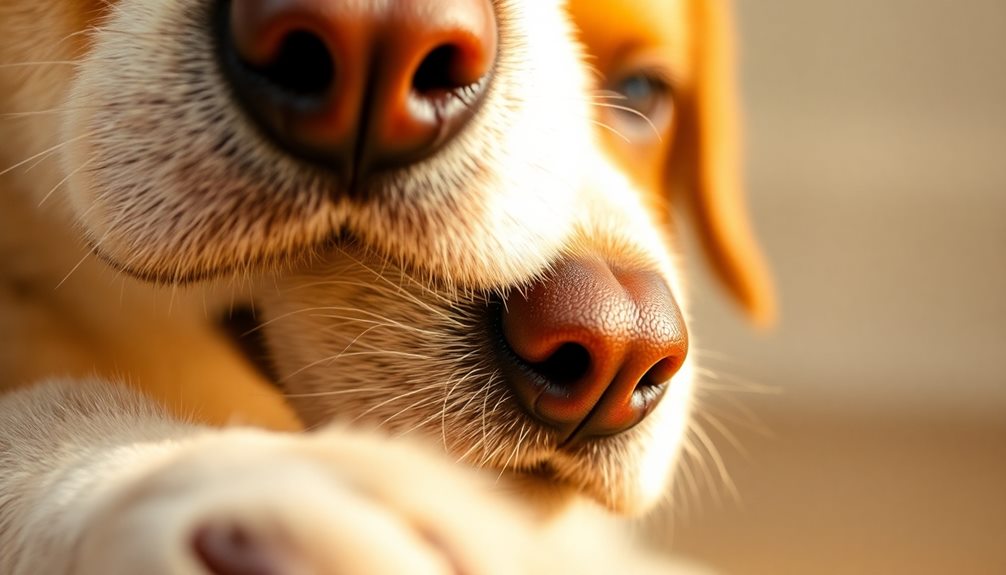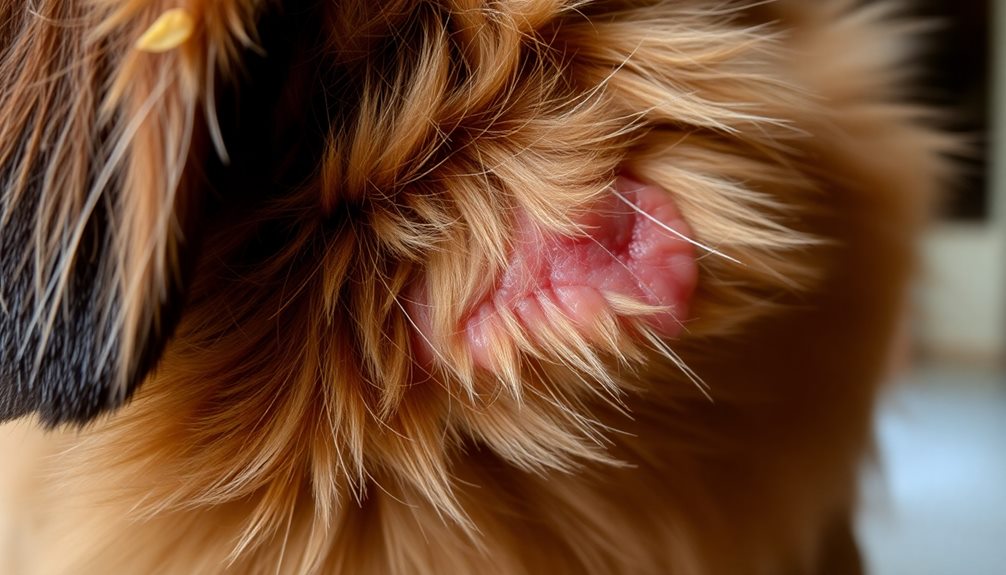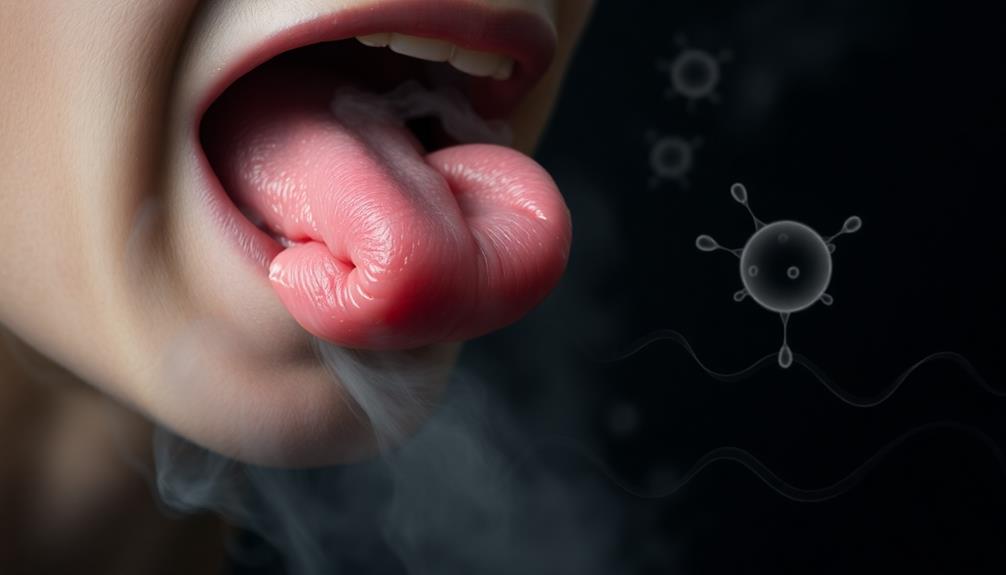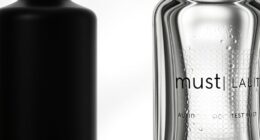When your dog has a yeast smell, it often feels musty, kind of like bread or beer. This strong odor usually comes from areas where warmth and moisture build up, like their ears, paws, or skin folds. If you notice a sour scent, it might mean there's an overgrowth of fungi, which can cause itchiness and redness. It's important to act quickly! Regular grooming and keeping your pup dry can help prevent this smell. If you're curious about what to do next for your furry friend, there's plenty more helpful information waiting for you!
Key Takeaways
- Yeast smell on a dog is often described as musty, similar to bread or beer.
- The odor can be strong and noticeable around the ears, paws, and skin folds.
- A sour or tangy scent may indicate underlying skin health issues related to yeast overgrowth.
- Accompanying signs include greasy or sticky fur, redness, and itchiness in affected areas.
- Early intervention and veterinary consultation are crucial for addressing the yeast smell and preventing further discomfort.
Introduction

When you notice a yeast smell on your dog, it can raise immediate concerns about their health and hygiene. You might wonder if it's something serious or just a minor issue. This smell often indicates an overgrowth of yeast, which can happen for several reasons.
It's important to pay attention to your furry friend because they rely on you to keep them healthy and happy. Yeast thrives in warm, moist areas, so it's common to find it in the ears, paws, or skin folds.
If your dog's skin is red, itchy, or inflamed, it might be a sign that yeast is taking over. You'll want to observe their behavior, too. Are they scratching or licking more than usual? These actions can indicate discomfort, and it's your job to help them find relief.
Taking action sooner rather than later is key! A visit to the vet can provide guidance and treatment options to help your dog feel better.
Description of the Smell

A distinct, musty odor often characterizes the yeast smell on your dog, resembling the scent of bread or beer. When you get close, it might remind you of a bakery, but in a less delightful way. This smell can be quite strong and may catch your attention right away. You might notice it around their ears, paws, or skin folds where moisture tends to gather.
As you lean in, the scent may feel a bit sour or even tangy, sort of like a forgotten snack left out too long. It's not just unpleasant; it suggests that something's off with your pup's skin health. If your dog's fur feels greasy or sticky along with that smell, it can be a clear sign of an overgrowth of yeast.
Imagine the warm, comforting smell of fresh bread, then twist it into something less appealing. This contrast can be alarming, and you might feel concerned for your furry friend.
Addressing this odor early on can help keep your dog healthy and happy, ensuring they smell fresh and clean instead! Keep an eye (and nose) out for those signs.
Source and Composition

The yeast smell on your dog primarily comes from an overgrowth of specific fungi, particularly Malassezia pachydermatis. This tiny fungus naturally lives on your dog's skin. Under normal circumstances, it doesn't cause any issues. However, when it overgrows, it can produce that distinct, musty odor you might notice.
Malassezia thrives in warm, moist areas, making it more likely to multiply in places like the ears, paws, and skin folds. When the balance of bacteria and fungi on your dog's skin is disrupted, this fungus can take over.
Factors like allergies, skin irritation, or even a poor diet can contribute to this imbalance, leading to a yeast overgrowth.
The composition of Malassezia includes lipases, which break down fats, and fatty acids that can create the unpleasant odor.
You might find it helpful to keep an eye on your dog's grooming routine. Regular baths, using the right dog shampoos, can help manage this issue.
Typical Scenarios or Environments

In warm, humid weather, you might notice the yeast smell on your dog becoming more pronounced. This often happens during summer months when your dog spends more time outside.
Think about those long walks in the sun or playful afternoons at the park. The heat and moisture create the perfect environment for yeast to flourish on your pup's skin.
If your dog loves to swim, that can also contribute to the smell. Wet fur, especially in areas like the ears and paws, can trap moisture, making it easier for yeast to grow.
After a day at the beach or a dip in the pool, you might catch a whiff of that distinct scent.
Another common scenario is after your dog has been playing in tall grass or mud. These environments can introduce bacteria and yeast, leading to an unpleasant odor.
Emotional or Cultural Associations

Noticing a yeast smell on your dog can evoke a range of emotions, from concern to frustration. You might feel worried about what the odor means for your furry friend, and that's completely normal. Our pets are like family, so any unusual smell can trigger a protective instinct.
You may also feel embarrassed if others notice the smell, thinking it reflects poorly on your care for your dog.
Culturally, certain smells can carry specific meanings. In some cultures, the scent of yeast might remind you of baking bread, evoking warm memories of family gatherings or sweet treats. Yet, when it's on your dog, those memories might clash with feelings of anxiety.
Additionally, you might find yourself comparing your experience with other dog owners. Sharing stories can help ease your worries. Engaging in conversations about your dog's health can create a sense of community, as you all navigate the joys and challenges of pet ownership.
Ultimately, understanding the emotional layer linked to a yeast smell can help you approach the situation with care and clarity, turning worry into proactive steps for your beloved companion.
Health or Safety Considerations

When you detect a yeast smell on your dog, it's important to consider the potential health implications. This odor often points to a yeast infection, which can affect your dog's skin, ears, or even their paws. Yeast thrives in warm, moist places, so areas like between the toes or in the folds of skin can become hotspots.
If you notice the smell, check for other signs such as redness, itchiness, or discharge. These can indicate that the yeast has taken hold and needs attention. Ignoring this smell could lead to discomfort for your furry friend, and it might even get worse over time.
You should definitely consult your veterinarian if you notice the smell along with other symptoms. They can help diagnose the problem and recommend proper treatments, like medicated shampoos or dietary changes.
Final Thoughts

Dealing with a yeast smell on your dog can be concerning, but recognizing the signs early can make a significant difference. That funky odor often signals an underlying issue, like a yeast infection, which can lead to discomfort for your furry friend.
You might notice them scratching more than usual or showing signs of irritation. It's essential to pay attention and take action.
Start by examining your dog's ears, paws, and skin for redness or swelling. If you spot any of these signs, don't hesitate to consult your vet. They can help you figure out the best treatment plan.
You can also support your dog's health with a balanced diet, regular grooming, and proper hygiene. Keeping your pup clean and dry helps prevent yeast overgrowth.
Frequently Asked Questions
Can All Dogs Develop a Yeast Smell?
Yes, all dogs can develop a yeast smell. Factors like allergies, skin infections, and diet can contribute to yeast overgrowth. If you notice an unusual odor, it's best to consult your veterinarian for advice.
How Can I Prevent Yeast Infections in Dogs?
To prevent yeast infections in dogs, keep their ears clean and dry, bathe them regularly, and maintain a balanced diet. Also, consult your vet for specific recommendations tailored to your dog's needs.
Are Certain Dog Breeds More Prone to Yeast Smells?
Certain dog breeds, like Bulldogs and Cocker Spaniels, are more prone to yeast issues due to their skin folds or moisture retention. You'll want to monitor their grooming and hygiene closely to prevent problems.
What Treatments Are Available for Yeast-Related Odors?
To tackle yeast-related odors, you can try antifungal shampoos, dietary changes, or probiotics. Regular cleaning and drying of your dog's ears and skin also helps. Consulting your vet ensures you choose the best treatment.
How Can Diet Influence Yeast Smell in Dogs?
Diet plays a crucial role in managing yeast odors. You can reduce yeast growth by feeding your dog a balanced diet low in sugars and carbohydrates, while incorporating probiotics to support healthy gut flora and overall well-being.









